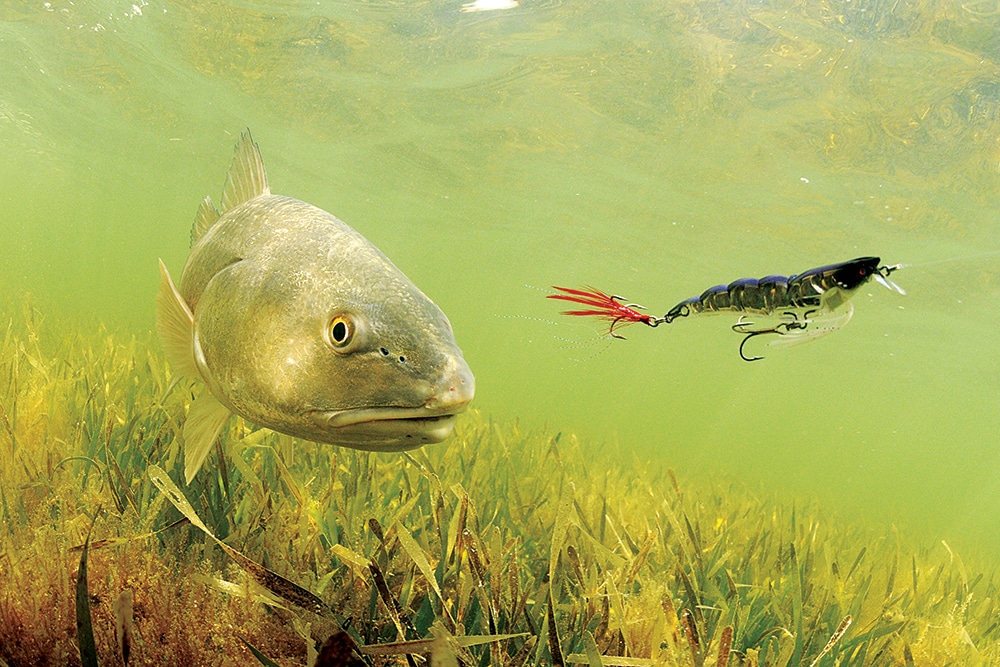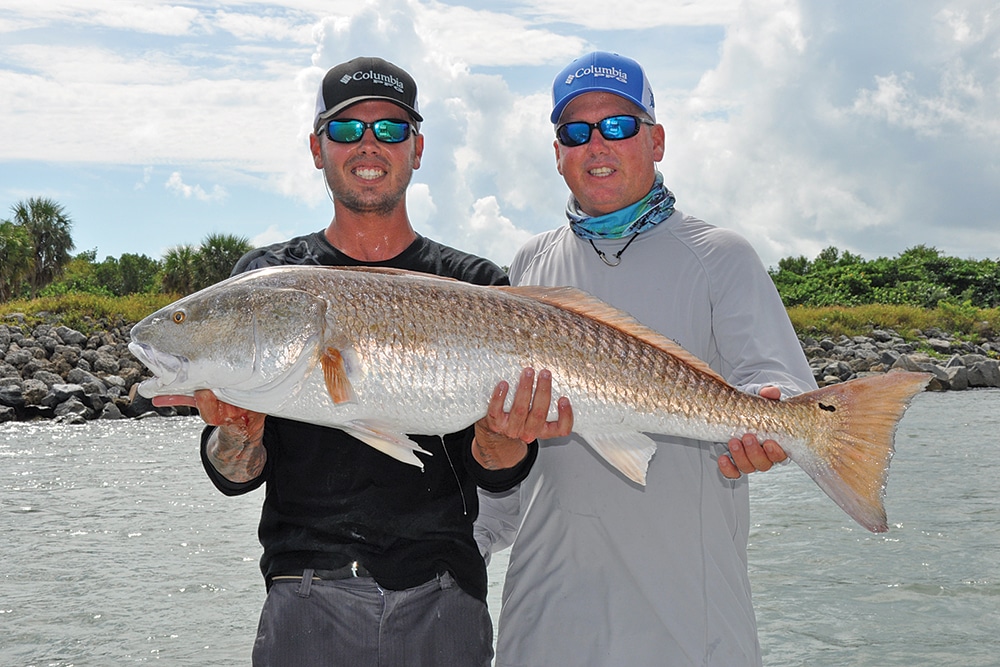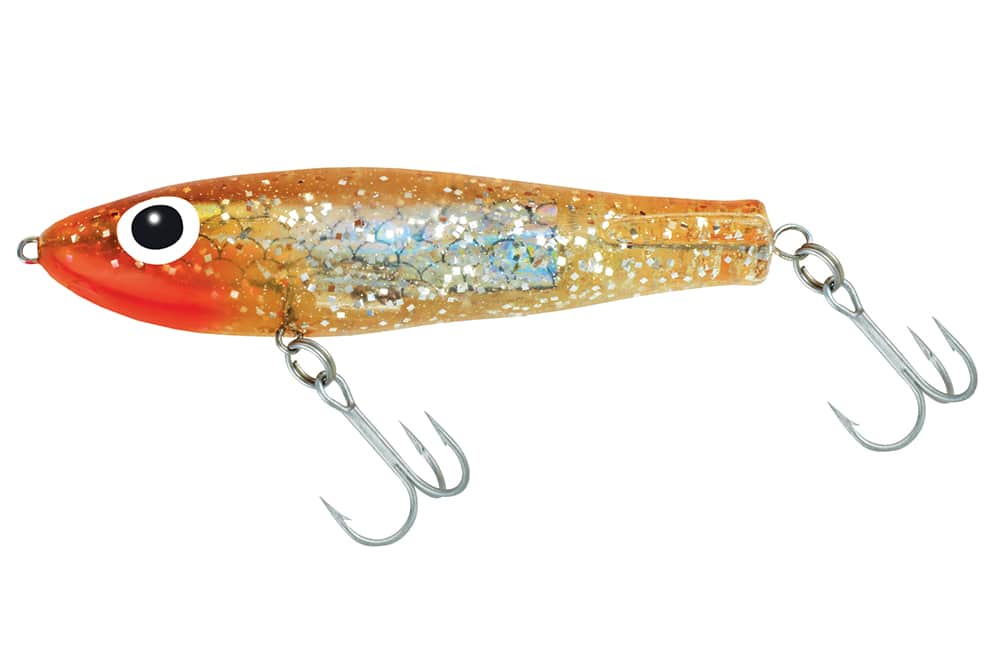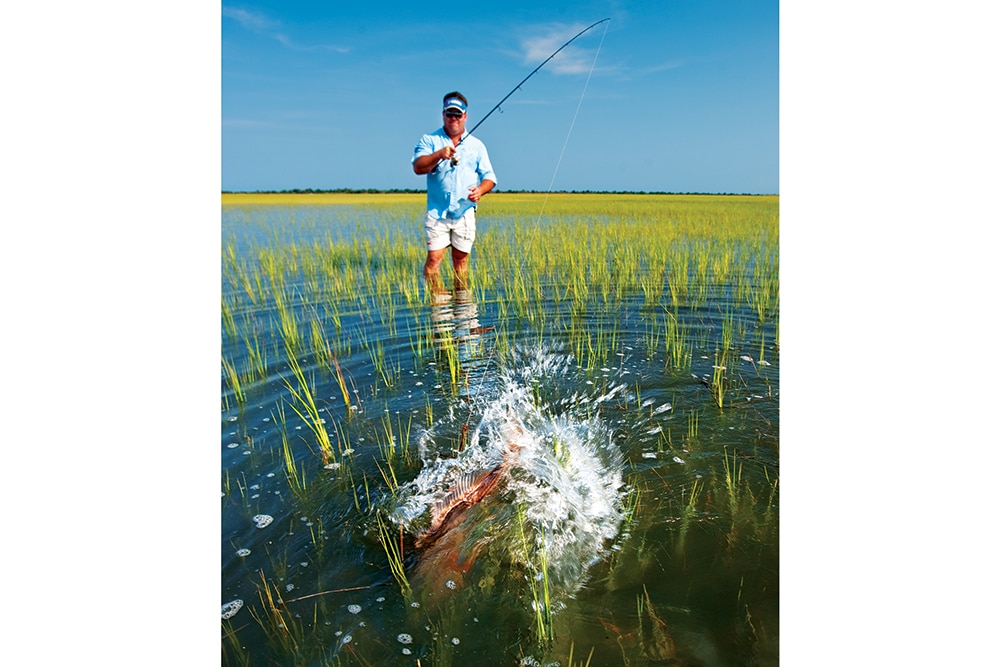
On the Prowl
Travel time is not an issue when targeting the most popular coastal game fish if you live in the Southeast — they’re always in your backyard. And learning how to catch redfish isn’t all that difficult once you get down the basics. Redfish, also known as red drum, are widespread in their range of where you can find them. Another plus is that they don’t care much about structure, water depth or clarity, as long as there’s plenty of food available. That’s not to say redfish don’t adjust to environmental factors, it’s just that they thrive in so many different conditions.
I learned just how adaptable redfish are when I hiked a trail along Florida’s Indian River Lagoon. Scouting among the overgrown mangroves, I spotted redfish tailing in a mosquito ditch not more than 5 feet wide. The red drum favored the mud-bottom canal instead of lush grass flats refreshed regularly with tidal movements on the other side of the berm. Still, these redfish — the biggest in the area — chose a 1- to 2-foot-deep trough, even with access to the lagoon via drainage culverts at high tide. I had to cast to them, among the spider webs and branches, even if I didn’t understand what they were doing there. When I convinced a big bull redfish to bite, the maze of mangroves I crisscrossed to land and leader the fish was ridiculous, but it was completely worth it.
From the Chesapeake Bay to Texas, anglers have abundant opportunities to catch redfish. Redfish of all sizes inhabit brackish creeks, marshes, grass flats, mangroves, oyster beds, bridges, passes and beaches of the Southeastern states. Pick the structure that fits your favorite style of fishing, or target new waters that have gone unexplored. The best part of fishing for redfish is that you can find them just about anywhere.
I interviewed local captains from Texas to Florida to highlight redfishing tips and techniques for five different habitats. These are some of the best ways to catch redfish:
Fishing Inlets and Passes for Redfish
One of the most dangerous places to cast a line in Texas is also the fishiest. Trophy redfish hang around sudsy jetties year-round, taking advantage of tidal flow like a conveyor belt delivering food.
“Strong tidal currents at the jetties create waves as current floods and ebbs in and out of the bay,” says Capt. Brad Stanford, of Pirate of the Bay Charters in Rockport. “If seas are running 2 to 3 feet offshore, and you have a very strong outgoing tide, the waves could be even bigger at the mouth of the Port Aransas jetties. Pay close attention to your surroundings as you fish the rocks to minimize risk.”
Late summer into early fall is when the bulls start showing regularly around jetties, increasing in numbers through fall and early winter during annual spawning runs. That’s the best time of year to catch the big boys, says Stanford.

Make sure to use your depth finder to mark drop-offs near the jetty when fishing for redfish.
“My best spots tend to drop off from 8 to 30 feet,” he says. “The strong current washes bait across the shallows over deeper sections, where big reds wait to ambush baitfish.”
If you want to know how to catch big redfish, live baits like mullet, croakers and mud minnows are the top presentation. “In early fall, mullet congregate around the jetties for their spawn, coinciding with the bull reds running. Typically, a 4- to 8-inch mullet works, but it’s a trade-off. The bigger the bait, the bigger the redfish, but you’re a lot less likely to catch much else with the bigger bait.”
Artificial-lure anglers attack the jetty differently.
“Cast to smaller reds early in the mornings along the rocks,” says Stanford. “Waves and current can make it hard to see at times along the jetty. When you can’t spot the reds, cast suspending lures such as Corkys (now Paul Brown’s Original Series, part of MirrOlure’s lineup) and Rat-L-Traps,” the guide advises.

Casting Along the Beaches
Good luck finding a spot more consistent for bull redfish than Dixey Bar, a man-made mound that lines the ship channel entering Alabama’s Mobile Bay. Located off the point where Fort Morgan stands, the lengthy bar and nearby Dauphin Island beaches are a mecca for oversize red drum.
“The bar’s as shallow as a couple of feet, and sometimes you can see the reds schooling on top,” says Capt. Kevin Olmstead, of Point Clear Fishing Adventures in Mobile Bay. “That makes for truly exciting fishing. I usually fish the drop from 7 to 16 feet with 20- to 30-pound gear during an outgoing tide.”

Fall and early winter, when bunches of bait are flushed out of the bay, is a prime time to fish, even though all year can be productive. Light north winds seem to bring the fish to the top to feed, says Capt. Barnie White, a charter captain and tournament fisherman from Brewton, Alabama, and member of the White Fishing Team.
“These fish will push a ‘mullet ball’ to the surface, and when they get into that mode, double and triple hookups are not uncommon,” says White. “Watching those big fish blow up on a Badonk-A-Donk [a surface lure by Bomber] is a blast. The big reds on the beaches usually target mullet, so a popping cork with a soft plastic offers another option.”
Reds range in depths up to 30 feet deep — watch for birds and for blowups at the surface. The bulls also cruise in the surf, right along the breaks. The translucent blue tail always gives them away. Fishing from a boat with a strong trolling motor is effective.
“Most of the time they are in small packs of three to five fish,” says White. “They’re not spooky but are moving fast, and it takes a good eye and quick reactions to stay ahead of the fish for a cast.”

Sight-Fishing the Grass Flats for Redfish
Tails, you win, when fishing at Flamingo in Florida’s Everglades National Park.
“Reds tail in singles and schools,” says Capt. Jason Sullivan, of Rising Tide Charters, who fishes park waters regularly. “They will push big head wakes too. I have seen them in schools of 10 to 150, both tailing and cruising.”
Local knowledge is necessary to navigate the shallow flats, pole-and-troll zones, and shoal areas that make up northern Florida Bay. “If you spend enough time poling the flats and paying attention to the tides, you can definitely catch redfish on your own,” he says. “Where I fish on the flats, it takes a very shallow-draft skiff.”

The best areas are based directly on the tide. Some spots are better on the falling tide, and some are better during incoming. “I really want clean water when I’m looking for reds,” he says. “The right depth is when my skiff drags a little when I am poling.”
Sight-fishing for reds on the flats is the technique du jour in the Glades, but blind-casting in potholes or around islands is successful too. Tackle up with a 7-foot, medium-light rod and a 3,000-size reel spooled with 10-pound braid. For pothole fishing, Sullivan throws the popular hard-bodied Rapala SkitterWalk redfish lure or a ¼-ounce spoon. The top lure for sight-fishing is a soft bait rigged weedless on a worm hook.
When redfish are tailing, throw it past the fish and reel it to their nose. If the fish are cruising, cast in front of them along their forward path.
“It’s hard to beat poling up to a fish, making a presentation, and watching the bite,” admits Sullivan. “The other day my angler cast at a fish, and the red sucked down the Gulp! shrimp like a trout sipping a dry fly.”

Working Spartina Grass on the Flood Tide
Flood-tide redfishing is all about timing. Occurring just eight months out of the year in South Carolina, and only about 10 to 15 days each month, high waters allow red drum to explore mud and flats that are usually dry.
“Your tide logbook is your best friend,” says Capt. Owen Plair, who runs charters out of Bay Street Outfitters in Beaufort, South Carolina. Plair capitalizes on the Low Country phenomenon each year, targeting the short-stalked spartina flats.
Peak tides cover mud flats that grow spartina grass, allowing redfish to target otherwise unmolested numbers of fiddler crabs. April through November represent the optimum months, says Plair. After that, water temperatures drop below 65 degrees, signaling fiddler crabs to burrow into the mud.
“It’s a four-hour window of opportunity,” he says. “The key time to fish a flat is two hours before and two hours after. You want to spot fish as they’re first moving onto the flat from feeder creeks — that’s when these reds feed most aggressively. Fish can pop up anywhere on the flat, which makes this trip almost like a hunting expedition.”
With their noses in the mud and tails wagging in the air, flood-tide redfish are a hard-hitting bunch. Cast gold spoons or scented artificial baits rigged on a weighted weedless hook. “I use a Berkley Gulp! Peeler Crab with a chartreuse tail because the tail mimics a shrimp lighting up in the grass,” says Plair. Use a 4- to 6-foot section of 30-pound fluoro leader.
Presentation is key to catching flood-tide reds — you want to make sure your bait is in a fish’s vision. “Once you spot a tailing fish, you want to cast your artificial about 5 feet in front of the fish and 4 feet past it,” says Plair. “This will give an angler the opportunity to adjust the bait to the path of the fish. Slowly move the bait along the bottom like a crab or grass shrimp; a slight twitch with the rod tip is all you need to get an aggressive strike.”

Marsh Madness: Chasing Pond Pumpkins over Mud Bottom
From Venice, Louisiana, to the Biloxi Marsh, Capt. Greg Dini Jr., of Fly Water Expeditions, can’t think of a better landscape to sight-fish for giant redfish. There’s a reason the countless acres of wild marshland and mud bottom is often referred to as the Land of the Giants. Fishing out of Plaquemines and St. Bernard parishes, Dini never has to fish the same waters two days in a row.
“Keeper redfish are always around because of our light fishing pressure,” he says. “In the summertime, we’re fishing for reds up to 15 pounds. From mid-August to February, we see 20-pound fish up to 30 pounds on average. Conditions pending, it can be great year-round.”
Dini guides mostly fly anglers to the pond pumpkins but recommends 15- to 20-pound tackle for spin anglers, including 7-foot rods that cast jigs and topwaters precisely. Around the marsh, reds get their moniker from vivid-orange coloring on their sides in the backwater creeks and ponds in which they’re caught.
“The reds will be over mud, oyster, sand and even some grass,” Dini says. “Always watch where you’re running the boat because there are obstacles leftover from storms.”
If the reds are near baitfish or sitting motionless, throw poppers. Free swimmers at the surface, floating “high and happy,” make easy targets. When reds are moving with purpose, cast baits out in front to make sure they see them. Sometimes redfish will be in water so skinny that their back sticks out. Still, those fish readily eat well-placed soft plastics.
Marshes closest to the open Gulf of Mexico see fresh numbers of redfish moving in from deep water. The only downside to this fishery is reds’ sensitivity to weather changes, Dini says, since they might head back offshore as quickly as they came. Play the weather window right, and eager Louisiana redfish will leave your arms and hands sore but begging for more.








